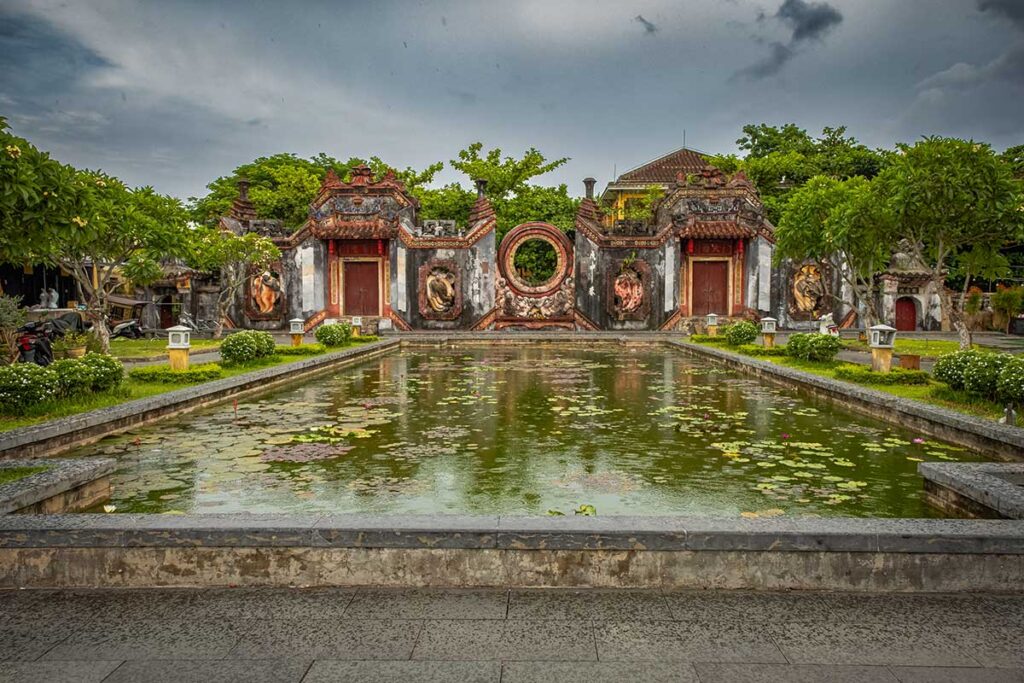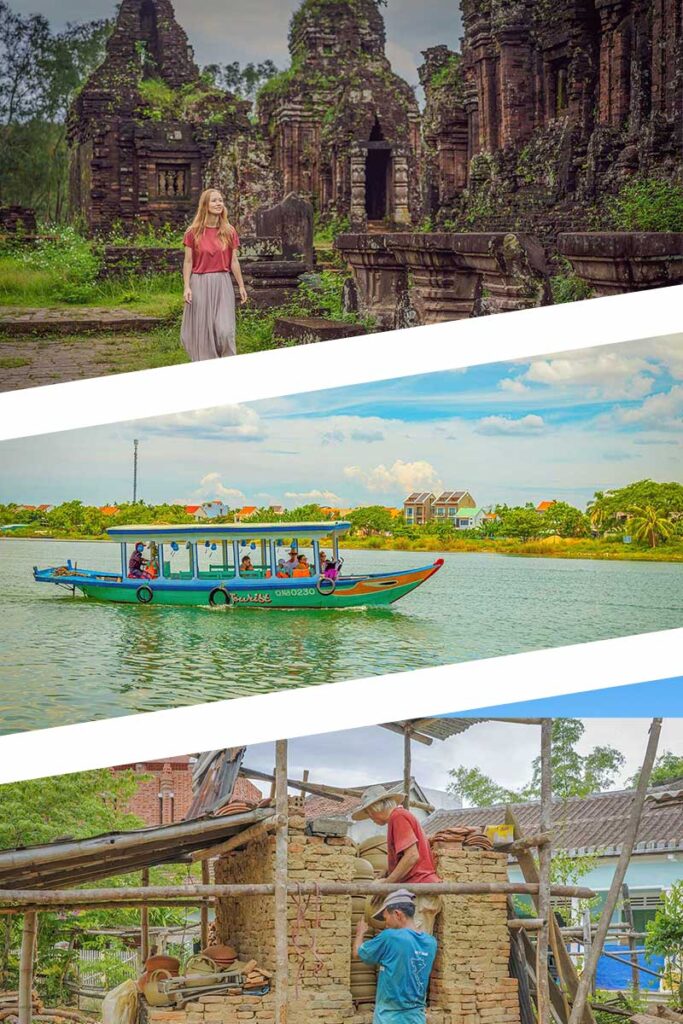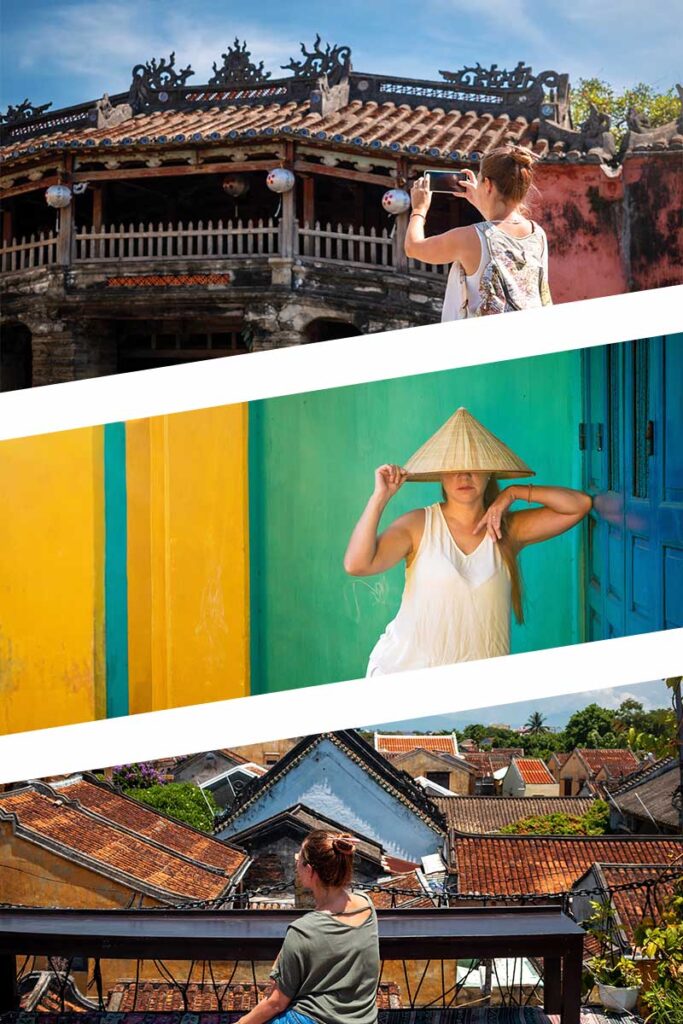1. My Son Sanctuary
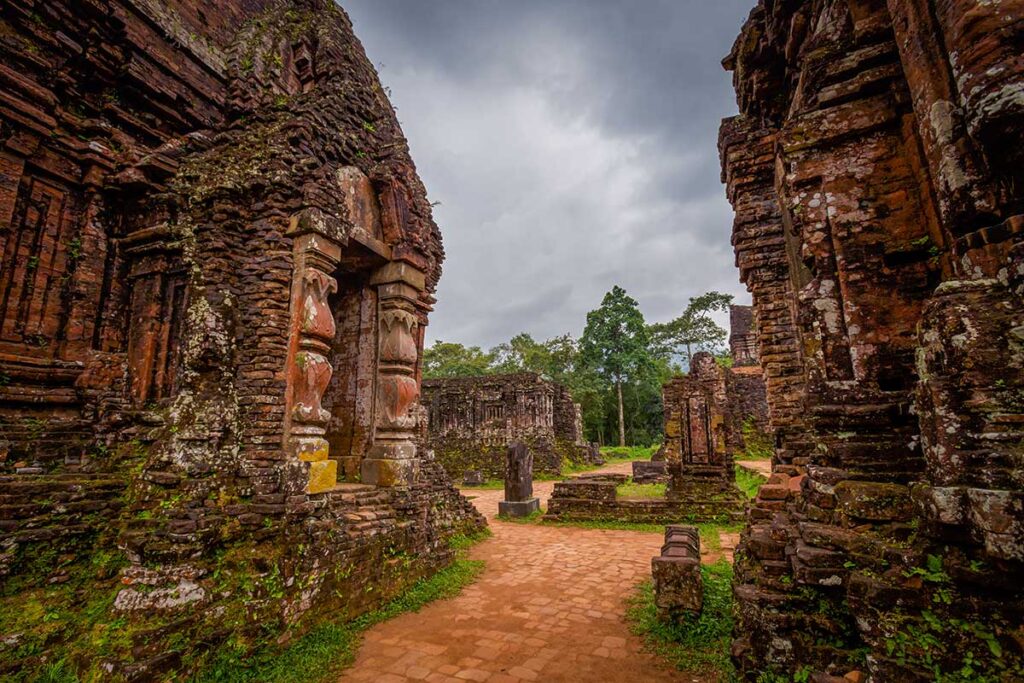
My Son Sanctuary is a UNESCO World Heritage Site and one of Vietnam’s most important archaeological treasures. Built between the 4th and 13th centuries by the Cham civilization, this complex of over 70 Hindu temples was dedicated to the god Shiva. The temples are nestled in a lush valley surrounded by mountains, creating a peaceful and atmospheric setting.
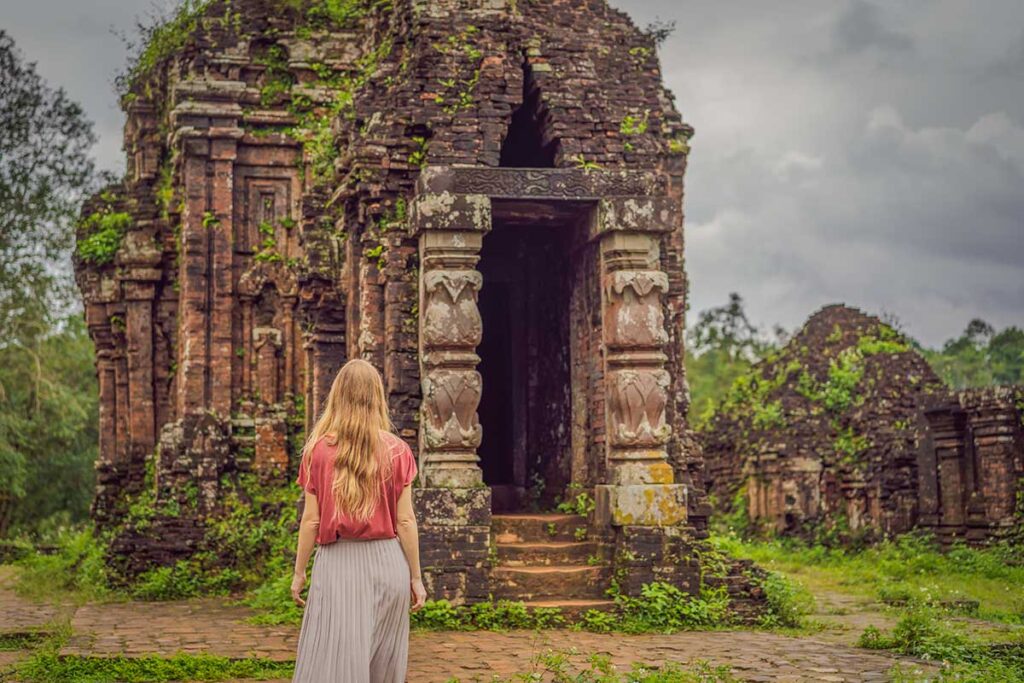
My Son was the spiritual heart of the Champa Kingdom, serving as a center for religious ceremonies and royal burials. The temples showcase intricate carvings and unique brickwork that reflect the Cham people’s devotion and architectural skill. Despite damage from time and war, many structures remain, offering insight into a once-thriving culture.
How to get there
Located about 40 km (25 miles) from Hoi An, My Son is accessible by several means:
- Guided tour: Convenient and informative, with options including sunrise or sunset visits.
- Private car: Offers flexibility; prices range from 700,000 to 900,000 VND for a round trip.
- Motorbike: For the adventurous, a scenic ride through rural landscapes; rentals cost around 100,000–200,000 VND per day.
- Public transport: Buses and taxis are available, but may be less convenient for early or late visits.
My Son Sanctuary Tour from Hoi An (Small Group or Private)
- Experience Discover My Son’s ancient Cham temples with a local guide in a small group or private tour.
- Includes: Hotel pickup, lunch, and scenic boat cruise back to Hoi An.
What to expect
The site is divided into groups of temples labeled A through H. While some structures are in ruins, others remain well-preserved, displaying detailed sculptures and inscriptions. Early morning visits are recommended to avoid crowds and heat. Entry fee is approximately 150,000 VND, and the site is open daily from 6:30 AM to 5:30 PM. Remember to dress modestly and bring water, as facilities are limited.
2. Hai Nam Assembly Hall

Hai Nam Assembly Hall is one of the more unique temples in Hoi An, built in 1875 by the Chinese community from Hainan. It was originally established to honor 108 merchants who were wrongly accused of piracy and executed. Today, it serves as both a temple and a quiet memorial space in the heart of the Old Town.
This temple in Hoi An stands out not just for its history, but for its message of justice and remembrance. The 108 merchants are now worshipped as protective spirits. Inside, you’ll find detailed wood carvings, golden calligraphy panels, and painted scenes that tell their story. It’s a great example of how Hoi An’s temples often reflect personal and community histories.
What to see inside
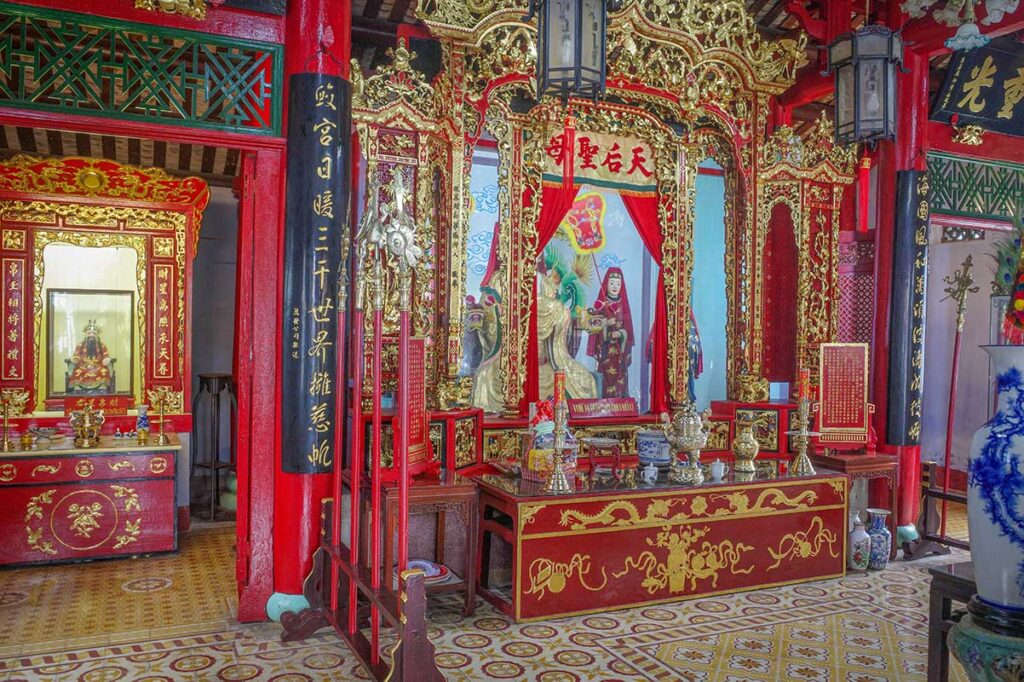
The architecture is classic Chinese, with curved rooftops, red lanterns, and a tranquil courtyard that offers a peaceful escape from the busy streets. Compared to some of the larger assembly halls, Hai Nam feels more intimate and relaxed — a good stop if you’re looking to slow down and appreciate the details.
Location and practical tips
You’ll find Hai Nam Assembly Hall right on Tran Phu Street, inside the Hoi An Ancient Town area. It’s included in the Old Town entrance ticket (120,000 VND), which covers multiple historic buildings. Combine it with other nearby temples and pagodas for a relaxed cultural walk. Just remember to dress modestly and remove your shoes when stepping into the prayer areas.
3. Quan Cong Temple
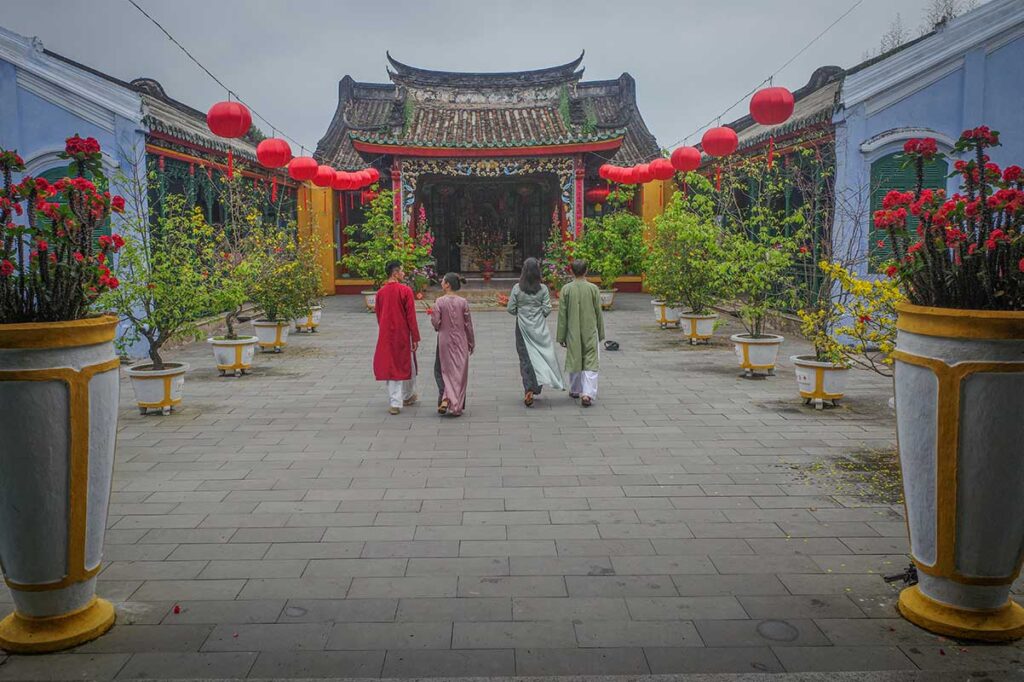
Quan Cong Temple is a small but important temple in Hoi An, located near the central market. It was built in the 17th century by Chinese merchants to honor General Quan Cong, a legendary figure known for his loyalty, bravery, and righteousness. Though modest in size, this temple remains one of the best temples in Hoi An for those interested in local beliefs and Chinese heritage.
General Quan Cong is revered not only as a military hero but also as a symbol of integrity. Traders used to visit this temple before long journeys, hoping for good luck and protection. That legacy still lives on, and the temple continues to be an active place of worship.
What to see inside

Despite its small footprint, the temple has a peaceful courtyard, a koi pond, and a semi-open roof that lets in natural light. Inside, the altar holds a striking wooden statue of Quan Cong, surrounded by red pillars, gold calligraphy, and incense coils. The atmosphere is calm and respectful, a nice break from the busy streets just outside.
Location and tips
You’ll find Quan Cong Temple right at the edge of the central market in Hoi An’s Old Town, making it easy to visit during a walking tour. It’s included in the Old Town ticket, so there’s no extra fee. Try visiting in the early morning or later in the afternoon when it’s quieter, and take a moment to enjoy the peaceful setting before diving back into the market buzz.
4. Phuc Kien Assembly Hall (Fujian Hall)
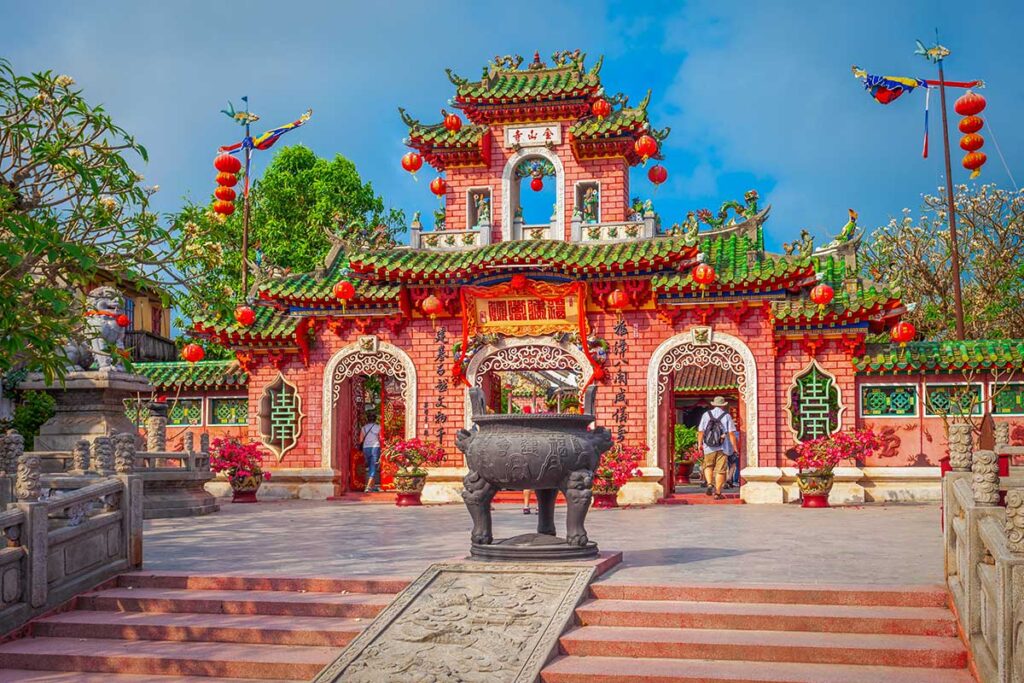
Phuc Kien Assembly Hall, also known as the Fujian Hall, is one of the most impressive and colorful temples in Hoi An. Originally built by the Fujian Chinese community in the late 1600s, it was later turned into a temple dedicated to Thien Hau, the goddess of the sea, who is believed to protect sailors and fishermen.
This is one of the best temples in Hoi An for experiencing the blend of faith, art, and community. Thien Hau holds a special place among Chinese seafaring communities, and the hall was not only a spiritual center but also a gathering place for Fujian traders. Today, it’s a major stop on many walking routes through the Old Town, and it still draws people looking for good fortune and safe travels.
What to see inside
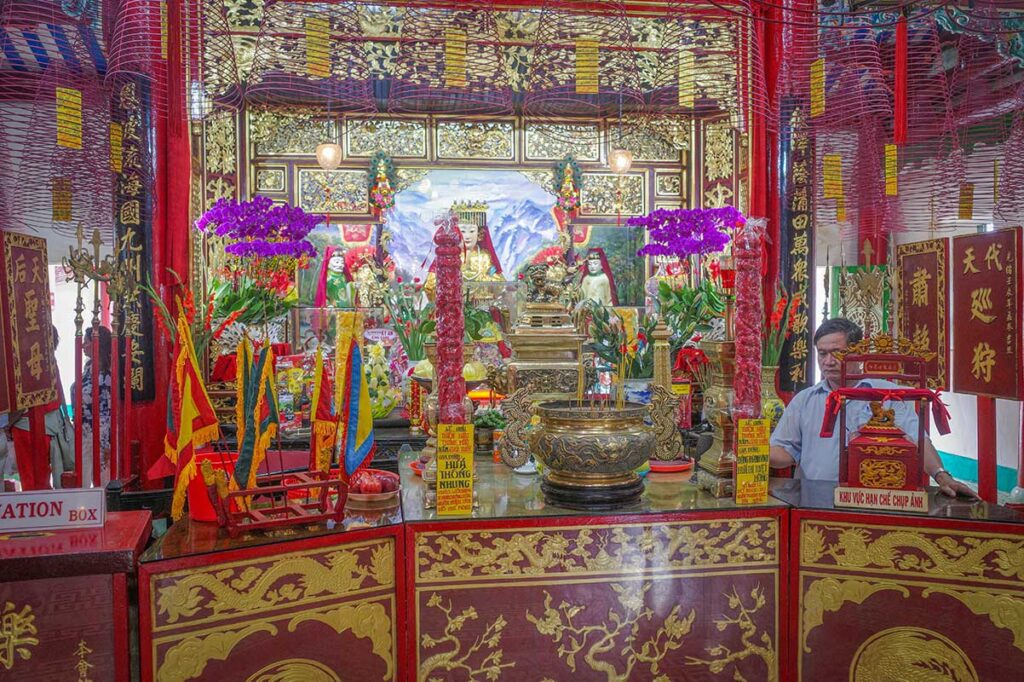
From the moment you step inside, the bright colors and ornate details stand out. The temple features dragon statues, ceramic fountains, painted wooden altars, and a courtyard filled with incense and symbolic decorations. Don’t miss the mosaic of a carp turning into a dragon — it’s a classic image in Chinese mythology symbolizing success and transformation.
Location and tips
Phuc Kien Assembly Hall is located on Tran Phu Street and is part of the Hoi An Old Town ticket package. It’s easy to combine with other nearby temples and pagodas. Because of its popularity, it can get busy, so early mornings are the best time to visit if you want to enjoy the space without crowds. Take your time to explore the courtyard and back altar halls — there’s more to see than it first appears.
Hoi An Walking Tour by Local Guide
- Experience Explore Hoi An’s Ancient Town on foot with a knowledgeable local guide.
- Includes: Historic houses, temples, market visit, and a relaxing coffee break.
5. Tran Family Chapel
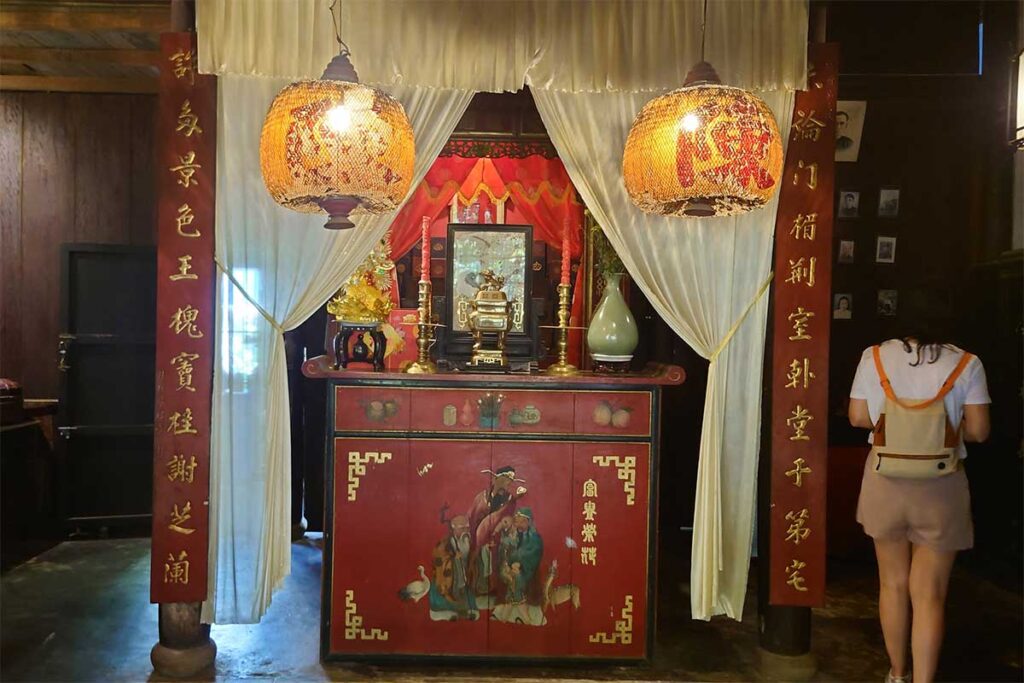
The Tran Family Chapel is a mix of a temple and an ancestral home, built in the early 1800s by one of Hoi An’s prominent mandarin families. It serves as a private place of worship and remembrance for the Tran family’s ancestors, and it’s still cared for by their descendants today.
While it’s not a temple in the traditional sense, this site gives you a personal look at how family worship plays a role in Vietnamese spiritual life. The chapel reflects the Confucian value of filial piety and the importance of honoring one’s roots. If you’re interested in understanding the local culture beyond just the big sights, this is one of the best places in Hoi An to do so.
What to see inside
The architecture blends Vietnamese, Chinese, and Japanese influences — a reminder of Hoi An’s diverse history. You’ll walk through a small courtyard before entering the main worship space, where the family altar holds portraits, offerings, and ceremonial items. It feels more intimate than other temples or pagodas in Hoi An, giving you a glimpse into daily spiritual life.
Location and tips
The chapel is located just off the main walking route in the Old Town and is included in the entrance ticket. A family member or guide often shares the site’s history, and the tour usually ends in a small souvenir shop. While the sales pitch can feel a bit pushy, you’re not obligated to buy anything. If you’re curious about ancestral traditions in Vietnam, the Tran Family Chapel is a quick but meaningful stop.
6. Japanese Covered Bridge

The Japanese Covered Bridge is one of the most iconic landmarks in Hoi An — and while it’s technically a bridge, it also functions as a small temple. Built in the 1590s by the Japanese trading community, the bridge was meant to connect them with the Chinese quarter across the stream, symbolizing peace and cooperation between the two groups.
This isn’t just a photo spot. Inside the bridge sits a tiny shrine dedicated to Tran Vo Bac De, the Taoist god believed to control the weather and natural disasters. The structure itself is a rare example of Japanese architecture in Vietnam and is one of the few spiritual sites that also serves a practical purpose. For many, it’s a must-see among the best temples and cultural landmarks in Hoi An.
What to see inside

The bridge features a tiled roof, arched wooden beams, and carvings of monkeys and dogs — symbols tied to the years construction began and ended. It’s small and often busy, but still carries a quiet charm, especially when viewed from across the water at night, when it’s softly lit.
Location and tips
You’ll find the Japanese Covered Bridge at the western edge of the Ancient Town. It’s part of the Old Town ticket and usually gets crowded during the day. If you want to enjoy it in a quieter moment, go early in the morning or later in the evening when the lights are on and the surrounding area feels more peaceful. While it’s a short visit, its historical and symbolic value makes it worth including on any walking route through Hoi An.
7. Chuc Thanh Pagoda

Chuc Thanh Pagoda is the oldest Buddhist pagoda in Hoi An, founded in 1454 by a Chinese monk named Minh Hai. Unlike the more decorative temples in the Old Town, this pagoda is simple and serene, with a quiet charm that makes it feel worlds away from the tourist crowds.
As one of the most historic pagodas in Hoi An, Chuc Thanh has long been a place of worship and learning for local monks. It’s a peaceful spot where the focus is more on daily practice than ceremony or display. If you’re looking for an authentic spiritual experience in Hoi An, this is one of the best places to find it.
What to see inside
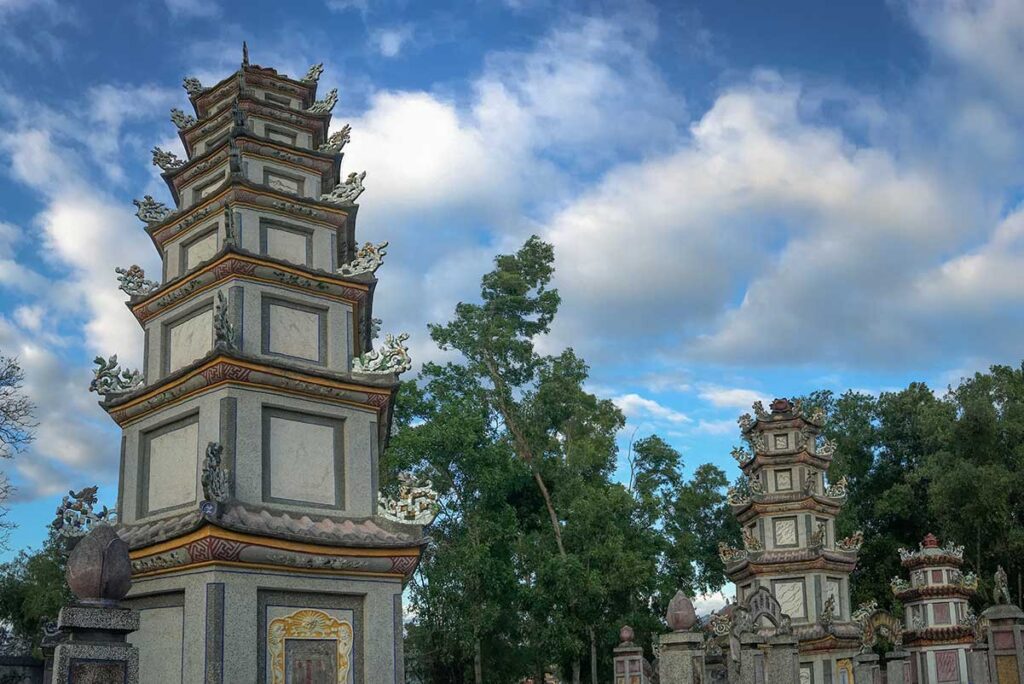
Set on spacious grounds with large trees and manicured gardens, the pagoda features modest prayer halls, old wooden altars, and a collection of statues — including a central Buddha and guardian deities. There’s also a quiet cemetery where former monks are buried, adding to the reflective atmosphere. You may see resident monks tending to the grounds or chanting in the hall.
Location and tips
Chuc Thanh Pagoda is about 10 minutes north of the Old Town by bike or taxi. It’s not part of the Ancient Town ticket, and entry is usually free, though donations are welcome. Because it’s a functioning place of worship, dress respectfully and keep your voice down. If you want to see a real local pagoda without the crowds, this is one of the best spiritual stops in Hoi An.
8. Quan Am Pagoda

Tucked away behind the better-known Quan Cong Temple, Quan Am Pagoda is a quiet, lesser-known gem that often gets overlooked. It’s a small Buddhist temple in Hoi An dedicated to the bodhisattva of compassion, Quan Am (also known as Guanyin). While not as grand as other sites, it has a warm, lived-in feel that reflects its role as a true local place of worship.
This is one of those temples in Hoi An where you can really slow down. Inside, you’ll find simple altars, hanging incense coils, and a series of scrolls and paintings that depict Buddhist stories, nature scenes, and calligraphy. The artwork gives the space a reflective, almost meditative vibe — making it a peaceful stop for anyone interested in the more personal side of spiritual life here.
What to see inside

The layout is modest, with three small altars and an open courtyard. Instead of ornate dragons or gold-leaf details, the charm here lies in the simplicity: faded wood, hand-painted walls, and soft light filtering through the roof. Local worshippers still stop by to light incense or leave offerings, so it feels active without being touristy.
Location and tips
Quan Am Pagoda is just a short walk from the central market, behind the Quan Cong Temple. It’s easy to miss, but that’s part of what makes it special. It’s usually not listed on the main ticket circuit, so entry is free. If you’re looking to experience one of the more authentic and peaceful pagodas in Hoi An, this quiet spot is well worth a visit.
Background: Religion and temples in Hoi An
Hoi An has always been a meeting point of cultures, and that’s especially clear in its spiritual life. Over the centuries, Chinese, Japanese, and Vietnamese communities brought their own beliefs — including Buddhism, Taoism, Confucianism, and ancestor worship. Many of the temples in Hoi An were built by merchant groups or families, not just for worship but also as community spaces and gathering halls.
Today, these temples and pagodas are still used by locals for quiet prayer, lighting incense, and honoring ancestors. You might see offerings of fruit, flowers, or even snacks placed at the altars — all meant to show respect or ask for protection, luck, or health. While some sites feel more like museums now, others remain active spiritual places, especially early in the morning or on special lunar calendar days.
Understanding this blend of culture, trade, and tradition helps explain why there are so many different types of temples in Hoi An — from grand assembly halls to small family shrines. They’re not just beautiful buildings; they’re a living part of the city’s identity.
Practical tips for visiting temples in Hoi An
To make the most of your temple visits in Hoi An, it’s good to be prepared. These practical tips will help you explore respectfully and understand what to expect. Whether you’re visiting the best-known temples or a quiet pagoda off the main path, a little cultural awareness goes a long way.
Dress modestly
Most temples in Hoi An ask that you cover your shoulders and knees as a sign of respect. While dress codes aren’t always strictly enforced, it’s better to be prepared — especially if you plan to step inside prayer halls. You’ll also need to remove your shoes before entering indoor areas.
Hoi An Old Town ticket required
Many temples and assembly halls are located within the Ancient Town, and you’ll need a Hoi An Old Town ticket to access them. The ticket costs around 120,000 VND and includes entrance to five heritage sites of your choice. You can buy it at ticket booths near the main walking streets.
Lighting incense
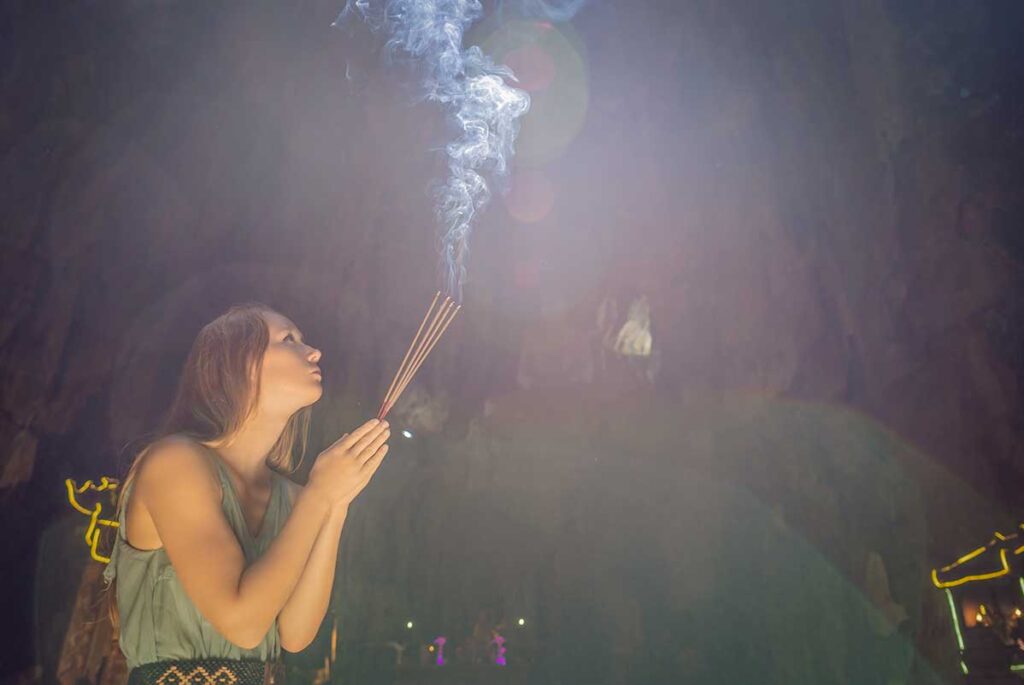
At several temples and pagodas in Hoi An, you’ll find incense available for offering. Lighting one or three sticks is a common way to show respect and quietly make a wish or prayer. Just follow the example of locals — it’s a peaceful ritual, not something to rush through.
Taking photos

You’re generally free to take photos, especially in courtyards, gardens, and other outdoor areas. Inside the temples, look for signs — if photography isn’t allowed, it will be clearly marked. Many Vietnamese also take photos at temples, so don’t worry about snapping a few respectful shots.
Respect active places of worship
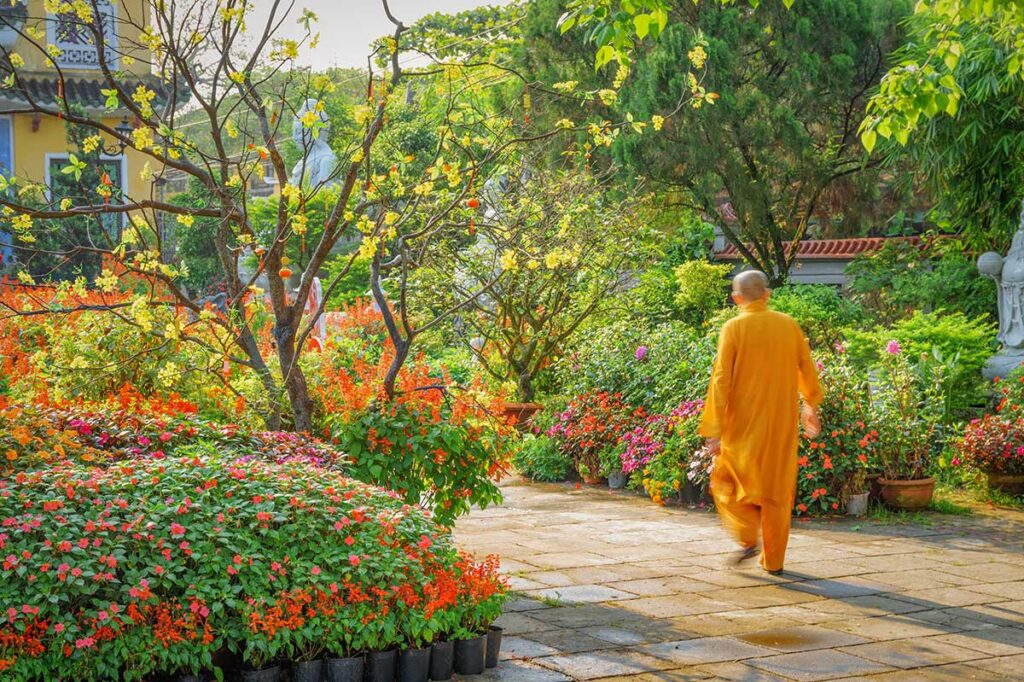
Not all temples in Hoi An are just for sightseeing. Some are still active religious sites where locals come to pray or make offerings. If you see people in prayer or a monk nearby, keep your voice low and step aside. These quiet moments are part of what makes visiting temples here so special.
